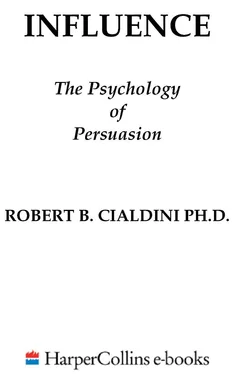—Robert B. Cialdini
Chapter 1 - WEAPONS OF INFLUENCE
Everything should be made as simple as possible, but not simpler.
—Albert Einstein
I GOT A PHONE CALL ONE DAY FROM A FRIEND WHO HAD RECENTLYopened an Indian jewelry store in Arizona. She was giddy with a curious piece of news. Something fascinating had just happened, and she thought that, as a psychologist, I might be able to explain it to her. The story involved a certain allotment of turquoise jewelry she had been having trouble selling. It was the peak of the tourist season, the store was unusually full of customers, the turquoise pieces were of good quality for the prices she was asking; yet they had not sold. My friend had attempted a couple of standard sales tricks to get them moving. She tried calling attention to them by shifting their location to a more central display area; no luck. She even told her sales staff to "push" the items hard, again without success.
Finally, the night before leaving on an out-of-town buying trip, she scribbled an exasperated note to her head saleswoman, "Everything in this display case, price x %," hoping just to be rid of the offending pieces, even if at a loss. When she returned a few days later, she was not surprised to find that every article had been sold. She was shocked, though, to discover that, because the employee had read the "%" in her scrawled message as a "2," the entire allotment had sold out at twice the original price!
That's when she called me. I thought I knew what had happened but told her that, if I were to explain things properly, she would have to listen to a story of mine. Actually, it isn't my story; it's about mother turkeys, and it belongs to the relatively new science of ethology—the study of animals in their natural settings. Turkey mothers are good mothers—loving, watchful, and protective. They spend much of their time tending, warming, cleaning, and huddling the young beneath them. But there is something odd about their method. Virtually all of this mothering is triggered by one thing: the "cheep-cheep" sound of young turkey chicks. Other identifying features of the chicks, such as their smell, touch, or appearance, seem to play minor roles in the mothering process. If a chick makes the "cheep-cheep" noise, its mother will care for it; if not, the mother will ignore or sometimes kill it.
The extreme reliance of maternal turkeys upon this one sound was dramatically illustrated by animal behaviorist M. W. Fox in his description of an experiment involving a mother turkey and a stuffed polecat. For a mother turkey, a polecat is a natural enemy whose approach is to be greeted with squawking, pecking, clawing rage. Indeed, the experimenters found that even a stuffed model of a polecat, when drawn by a string toward a mother turkey, received an immediate and furious attack. When, however, the same stuffed replica carried inside it a small recorder that played the "cheep-cheep" sound of baby turkeys, the mother not only accepted the oncoming polecat but gathered it underneath her. When the machine was turned off, the polecat model again drew a vicious attack.
How ridiculous a female turkey seems under these circumstances: She will embrace a natural enemy just because it goes "cheep-cheep," and she will mistreat or murder one of her own chicks just because it does not. She looks like an automaton whose maternal instincts are under the automatic control of that single sound. The ethologists tell us that this sort of thing is far from unique to the turkey. They have begun to identify regular, blindly mechanical patterns of action in a wide variety of species.
Called fixed-action patterns, they can involve intricate sequences of behavior, such as entire courtship or mating rituals. A fundamental characteristic of these patterns is that the behaviors that compose them occur in virtually the same fashion and in the same order every time. It is almost as if the patterns were recorded on tapes within the animals. When the situation calls for courtship, the courtship tape gets played; when the situation calls for mothering, the maternal-behavior tape gets played. Click and the appropriate tape is activated; whirr and out rolls the standard sequence of behaviors.
The most interesting thing about all this is the way the tapes are activated. When a male animal acts to defend his territory, for instance, it is the intrusion of another male of the same species that cues the ter-ritorial-defense tape of rigid vigilance, threat, and, if need be, combat behaviors. But there is a quirk in the system. It is not the rival male as a whole that is the trigger; it is some specific feature of him, the trigger feature. Often the trigger feature will be just one tiny aspect of the totality that is the approaching intruder. Sometimes a shade of color is the trigger feature. The experiments of ethologists have shown, for instance, that a male robin, acting as if a rival robin had entered its territory, will vigorously attack nothing more than a clump of robin-redbreast feathers placed there. At the same time, it will virtually ignore a perfect stuffed replica of a male robin without red breast feathers; similar results have been found in another species of bird, the bluethroat, where it appears that the trigger for territorial defense is a specific shade of blue breast feathers.
Before we enjoy too smugly the ease with which lower animals can be tricked by trigger features into reacting in ways wholly inappropriate to the situation, we might realize two things. First, the automatic, fixed-action patterns of these animals work very well the great majority of the time. For example, because only healthy, normal turkey chicks make the peculiar sound of baby turkeys, it makes sense for mother turkeys to respond maternally to that single "cheep-cheep" noise. By reacting to just that one stimulus, the average mother turkey will nearly always behave correctly. It takes a trickster like a scientist to make her tapelike response seem silly. The second important thing to understand is that we, too, have our preprogrammed tapes; and, although they usually work to our advantage, the trigger features that activa 3te them can be used to dupe us into playing them at the wrong times. 3
This parallel form of human automatic action is aptly demonstrated in an experiment by Harvard social psychologist Ellen Langer. A well-known principle of human behavior says that when we ask someone to do us a favor we will be more successful if we provide a reason. People simply like to have reasons for what they do. Langer demonstrated this unsurprising fact by asking a small favor of people waiting in line to use a library copying machine: Excuse me, I have five pages. May I use the Xerox machine because I'm in a rush? The effectiveness of this request-plus-reason was nearly total: Ninety-four percent of those asked let her skip ahead of them in line. Compare this success rate to the results when she made the request only: Excuse me, I have five pages. May I use the Xerox machine? Under those circumstances, only 60 percent of those asked complied. At first glance, it appears that the crucial difference between the two requests was the additional information provided by the words "because I'm in a rush." But a third type of request tried by Langer showed that this was not the case. It seems that it was not the whole series of words, but the first one, "because," that made the difference. Instead of including a real reason for compliance, Langer's third type of request used the word "because" and then, adding nothing new, merely restated the obvious: Excuse me, I have five pages. May I use the Xerox machine because I have to make some copies? The result was that once again nearly all (93 percent) agreed, even though no real reason, no new information, was added to justify their compliance. Just as the "cheep-cheep" sound of turkey chicks triggered an automatic mothering response from maternal turkeys—even when it emanated from a stuffed polecat—so, too, did the word "because" trigger an automatic compliance response from Langer's subjects, even when they were given no subsequent reason to comply. Click, whirr ! 4
Читать дальше












